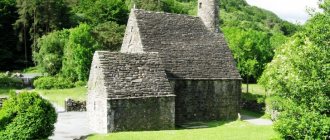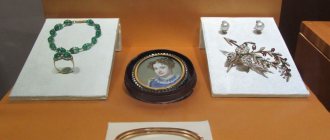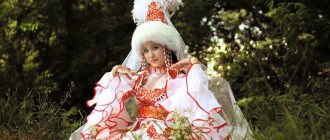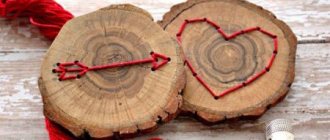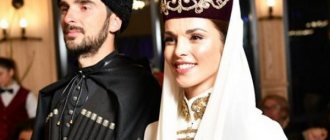Violation of tradition was strictly punished
If the tradition of hospitality was violated, then there could be severe consequences, and society considered such a host to be a criminal. In addition, the guest should also have restraint, and his actions should be aimed at curbing the extravagance of the owner of the house, who might even share the very last thing he has. If a guest visits the house more than once, then after the second and third visit, the owner and guest become kunaks, now both must try to support each other through the most difficult moments of life.
For a long time and to this day, kunaks were widespread throughout the republic, and the oath of two people had to be sealed by the exchange of bladed weapons. It should be noted that the kunak could not break his oath and had to remain faithful to his word, even if the most difficult trials fell on him. In addition, such a wonderful relationship could be inherited.
The latest news from Ingushetia is here.
Culture and history
- Architecture
- Folklore
- Islam
- Spiritual culture
- Crafts
- Tools
- Weapon
Material and spiritual culture of the Ingush
The Ingush are one of the most ancient peoples of the North Caucasus. They have their own independent history and culture. The ancestors of the Ingush created a rich, diverse, original material and spiritual culture that had connections with the culture of the peoples of the Caucasus and Western Asia. The material and spiritual culture of the Ingush developed in accordance with the nature of its economic activities, social relations, natural, geographical and historical conditions.
The material culture of the Ingush is represented, first of all, by monuments of architecture, housing and defense, funerary and religious purposes. Construction occupied a prominent place in the industrial activities of the Ingush. Towers, temples, sanctuaries, crypts are achievements of folk architecture. The Ingush knew how to build residential, semi-combat and combat pyramidal towers. Tower settlements were located in the mountains: on flattened spurs of mountains or in the depths of gorges. Castle complexes and defensive walls were also erected. The Ingush had their own professional craftsmen who owned a whole arsenal of equipment. The names of Ingush masters are known who have gained fame not only in their region, but also beyond its borders. These are Dugo Akhriev from Furtoug, Dyatsi Lyanov and Khazbi Tsurov from Dzheirakh, Barkhanoevs from Barkhane, Yand from Erzi, Hanoi Khing from Hani, Tet-Batyk from Targim, Albakovs from Tumga and many others. Professional builders were given an important role. The murder of an architect was considered a serious crime against the entire society.
Settlements and dwellings are an invariable attribute of the original material culture of the Ingush. In Russian sources, Ingush settlements were called taverns, auls, hamlets and villages. They were mainly located along the banks of the rivers Fortanga, Armkhi, Kistinka (Okhkar-khi), Kambileevka, Nazranka, Assa, Sunzha and Terek. The Ingush chose the place for their settlement carefully; they took into account the presence of water sources, the strategic position of the area, convenient location for defense, and the presence of nearby pasture, hay, forest and arable land. The settlements were small and located close to each other. The main type of Ingush dwellings in the mountains were residential towers built of stone - g1ala. On the plane, the dwelling was a single-chamber house. Changes gradually took place in the dwellings of the Ingush, especially in the lowland zone. The Ingush began to build long rectangular, turluch or adobe houses, in which each married couple had their own room. Russian house-building culture had a great influence on the home of the Ingush.
The most striking and expressive item of material culture of every nation is clothing. Among the Ingush it was varied. The needs for clothing and fabrics were met from the local raw material base, while imported fabrics were also used. Every family knew how to sew; women did this. Men's clothing was strict and modest, well adapted to local conditions, and at the same time distinguished by simplicity and elegance, which met their moral and aesthetic needs. The main elements of a men's costume were a shirt, trousers, a beshmet, a Circassian coat, a headdress, shoes and weapons. The beshmet was everyday clothing, the Circassian coat was worn on occasions when they went to visit, to a party, to a mosque, or village gatherings. Gazyrnitsa were sewn on both sides of the Circassian coat. Outerwear also included a burka and a sheepskin coat. As a headdress, the Ingush wore a hat (eltar-kiy) in winter and a hat (mangal-kiy) in summer. At the beginning of the 20th century. They began to wear caps later than hats. The shoes were varied - leggings, rawhide shoes. Later, boots (ikkash) and galoshes appeared. Women's everyday clothing was a shirt dress (koch) and trousers worn underneath (sharbal). Women's festive costume was chukhi, which was made of silk, velvet and brocade. The attributes of chukkha were caps in the shape of a truncated cone with gold and silver embroidery, as well as special bibs with clasps and a belt made of bronze and silver plates, decorated with engraving, niello, granulation, gilding, and semiprecious stones. Women's headdresses were varied - scarves, shawls, and also a special horn-shaped headdress - kurkhars. The Ingush women's footwear consisted of soft morocco boots and shoes with a blind toe without a back. Shoes were made from rawhide and morocco, which confirmed the spread of leather craft among the Ingush. In addition to shoes, leather was used to make pouches, belts, covers, saddles, harnesses, etc. The development of weaving is evidenced by spindle whorls found as a result of archaeological excavations. Among home-made fabrics, cloth occupied the first place, which was associated with the development of sheep farming.
Ingush women used various decorations. They wore copper, bronze and silver temple rings, as well as carnelian and glass beads. The production of temple rings was apparently mastered by Ingush craftsmen.
The Ingush have developed such crafts as weapons, pottery, blacksmithing, and jewelry, which in general, based on the available materials, are characterized by a fairly high level of professionalism. Metalworking has been widely developed among the Ingush since ancient times. Local artisans skillfully combined various metal processing operations: graining, blackening, gilding, and inlaying with multi-colored inserts. The most famous centers of jewelry making among the Ingush were Tsecha-Akhk, Tsori, Yevloy, Verkhniy Alkun, Egikal, Erzi, Metskhal.
The ancestors of the Ingush were also skilled gunsmiths. The weapons of the medieval Ingush warrior included: bow, arrows, darts, spears, axes, slings, swords, and later daggers and sabers. From the 15th century Flintlock firearms are spreading among the Ingush. Armor and chain mail, helmets, shields, elbow pads and combat gloves served as protective weapons. The names of some Ingush gunsmiths have survived to this day: Dudik from Doshkhakle, Dost from Salgi, Patiev Temarko from Khamishki, Zokk from Shuan, Alpi from Khani, Berd from Tsizdi, etc.
Woodworking played a significant role in the economic life of the Ingush. They knew how to make utensils from wood. Wood carving developed. Craftsmen made carved window frames, doors, and furniture. The production of wheels, saddles, and wheel rims was also developed among the Ingush.
Since ancient times, dishes have been made from stone, wood, clay, copper, bronze and iron. The Ingush developed ceramic production. Various vessels, glasses, jugs and dishes were made from clay using polishing. Since the time of the Koban culture, the bearers of which were the ancestors of the Ingush, the tradition of decorating the handles of vessels with stylized heads or animal figures has been preserved. In the second half of the 19th century. Factory-made glassware and earthenware are already appearing.
Along with other components of material culture, food is one of the important components and characterizing indicators of an ethnic group. The Ingush cuisine was distinguished by a variety of dishes. The food mainly consisted of dairy, flour and meat dishes. The diet also included food from eggs, honey, beans, potatoes and drinks. Many researchers note the Ingush's moderation in food. The national dishes of the Ingush are meat with dumplings and garlic sauce (dulkh khaltam), churek made from corn flour (siskal), ch1apilgash, dattakh, k1odar, khovla, khingal, etc.
An integral part of the Ingush culture was spiritual culture, the structure and character of which were determined by the economic structure and level of material production. The spiritual culture of the Ingush was distinguished by its richness and diversity of forms and played a leading role in their life.
The Ingush highly valued the art of healing. The names of doctors who relieved people’s bodily suffering and treated their ailments are preserved in the memory of the people. These are Bursak Buzurtanov, Bunho Buzurtanov, Berd Dzeitov, Berd Evloev, Bunho Tochiev and many others.
Astronomical knowledge played a significant role in life and worldview. The ancestors of the Ingush were aware of such concepts as the horizon, sky, cardinal points, etc. They revered the heavenly bodies and watched them. They also had their own calendar; they knew how to determine all four solar cycles. Time was counted from the present to the past or to the future. Significant periods of time were grouped into 11 and 33 years. Prominent Caucasus expert E.I. Krupnov believes that the Ingush “were familiar with the winter and summer solstices.” The celebration of the first cycle was timed to coincide with the winter solstice, the second to the spring solstice. The year consisted of 12 months, each of which had its own name
Each month was divided into four weeks of seven days. Calendar cycles were closely related to agriculture and cattle breeding and were based on the extensive practical experience of the people, astronomical observations and mathematical calculations. The main dates of the traditional calendar were celebrated with rituals and holidays. Calendar holidays, essentially labor holidays, dedicated to household work, could be divided into winter, spring, summer-autumn. These were: holidays of the spring equinox, in honor of the goddess Tusholi, the god Seli, the celebration of the winter solstice, the new year, holidays associated with the beginning of harvesting, haymaking, etc.
An important area of spiritual culture is oral folk art, which is a valuable source for studying the history of the Ingush people. Historical events of the past, ideas about the world around us, echoes of ancient religions, knowledge that existed but was forgotten, were preserved in the memory of the people in the form of traditions, legends, myths, fairy tales, heroic and lyrical songs. The works of oral folk art trace the worldview, worldview, moral and ethical ideals of the people, various aspects of their life and way of life, ideas about good and evil, nobility and justice, and give a popular assessment of many events and human actions. The folklore of the Ingush, along with its pronounced originality, has much in common with the oral folk art of other peoples. A special place in the folklore of the Ingush is occupied by the Nart epic, which was a spiritual support and, to some extent, predetermined the most general features of the national character, mentality and ethical and aesthetic ideals. The main characters of the Nart epic were: Koloy Kant, Seska Solsa, Sela Sata, Malkha Aza, Khamchi Pataraz, Nyasar, Botkiy Shirtka, Phyagal Bariy and others. The life of the main characters of the epic, their sayings and moral standards, were for the Ingush a model of courage, bravery, loyalty in friendship, an example of honesty and nobility. In the Nart epic, the Ingush were attracted by the chivalric spirit. The younger generation was brought up on the epic. The historical motifs outlined in the Nart epic are further developed in other genres of folklore. Heroic-epic songs (illi) occupy a large role in folklore. These songs develop themes of national liberation and social struggle. At the end of the XlX beginning of the XX centuries. Abrek songs appear, the heroes of which act as intercessors of the people. The song repertoire was varied. Lyrical and lullabies, ritual, comic, and lament songs stood out. Each village had its own songwriters and performers of folk songs, who were invited to festive events. At the same time, original musical instruments were used - a three-string violin with an arched bow, a dakhchan-pandar (mountain balalaika), and later a harmonica appeared, which was played by girls. The favorite dance of the Ingush was the Lezginka pair dance. A master-toastmaster was appointed to monitor order during the dances. Ingush dances had many variations, but they were all distinguished by their plasticity, gracefulness, elegance and simplicity.
A significant layer in the spiritual culture is occupied by the religious views of the Ingush, which went through a number of stages in their development - from early ideas to more developed systems. The earliest forms of religion include: totemism, animism, funerary cult and magic. The totem animals of the Ingush were: wolf, deer, bear, etc. Animistic ideas are associated with the spirits of nature and the elements, including: Khinana (Mother of Water), Darznana (Mother of the Blizzard), Mikhanana (Mother of the Winds), Mekhkanana (Mother of the Country), etc. The veneration of local mountains, rocks, stones, groves and lakes is associated with early religious beliefs. It was believed that the most revered pagan deities lived here. To communicate with them, stone sanctuaries and chapels were erected. The Ingush pantheon of pagan deities was distinguished by its complexity and fairly high level of development. In the minds of the people, it was presented in the form of a hierarchical ladder, where deities, in accordance with their significance in the life of the people, occupied certain steps. At the head of this staircase were - Dyala (the supreme god), Sela - the god of thunder and lightning, Tusholi - the goddess of fertility, Gal-Erda - the patron of cattle breeding, Elta - the owner of wild animals and the patron of hunters, Eshtr - the god of the underworld, Moldzy-Erda - god of War. For each of the listed deities, one or more sanctuaries were erected, at which public prayers with sacrifices were held.
Thus, in the course of historical development, a religious system was developed that was quite well adapted to the level of socio-economic development of the Ingush, to a certain economic and cultural type associated with arable, terrace farming and transhumance. A prominent place in the history of religious beliefs is occupied by Christianity, which penetrates to the Ingush first from Georgia (XII-early XIII centuries and XVIII centuries), later from Russia (XVIII - XIII centuries). In the Assinovskaya basin, three Christian temples were located: Tkhaba-Erda, Albi-Erda and T1argam-Erda. Early Christian stone-box burials of this period were found near the villages of Pamet, Lyazhgi, Metskhal, Shuan and others. Christianity did not take hold among the Ingush. The reasons for its decline are the persistence of pagan beliefs and the cessation of missionary activity in Georgia due to the invasion of the Mongol-Tatars.
Simultaneously with Christianity, Islam penetrates into the territory of Ingushetia from Chechnya and Dagestan, which can be traced on the surface earlier than in the mountains. Sources about the process of Islamization are early Muslim burial grounds, written evidence and some ethnographic data. Islam gained a foothold in Ingushetia in the 19th century. The last to accept the new religion in 1861 were the inhabitants of the Ingush village of Gvileti (Gelathoi). It should be noted that religious syncretism in the Ingush environment could be traced for a long time.
The social and family relations of the Ingush were very unique. The social life and way of life of the Ingush were regulated by unwritten norms, rules and customs. Economic, social, and judicial matters were decided at a general meeting of “khel” - council. The supreme governing body was the “Mekhk-Khel” - the country’s council, which met twice a year to discuss national issues and resolve controversial cases. Authoritative and respected people, experts in the customs and traditions of the Ingush, were elected as members of the Mekhk-Khel. All issues of economic and social life were regulated and regulated by adat norms and traditions.
Ingush etiquette was clearly developed. A characteristic feature that existed among Ingush traditions was a respectful attitude towards parents who were older in age. The rules of Ingush etiquette include such norms as the right of elders to sit in a place of honor, to speak first, not to interrupt or interfere in the conversation of elders, to give way to elders. Children are obliged to provide their parents with a decent old age. In the presence of elders, it was forbidden to speak obscenely, smoke, or make slips of the tongue. The Ingush never had nursing homes or orphans. Disrespect for elders and parents is severely condemned by society.
Ancient traditions and customs include: public mutual assistance (belkhi), hospitality, kunachestvo, twinning, adoption and patronage.
During mutual assistance (belkhs), they assisted each other in building a house, fencing, plowing, sowing, and harvesting. This was selfless help, which was primarily provided by relatives and neighbors.
The custom of hospitality played an important role in social life. A special room was allocated for guests, which had the best bedding and good furniture. The guest was entertained, a ram was slaughtered in his honor, and a party was held. He was under the protection of his owner. Violation of the custom of hospitality was regarded by society as a crime.
Among the diverse and unique cultural heritage of the Ingush, folk games and entertainment occupied a certain place. They were both domestic and social, aimed at both spiritual and physical development.
Dolgieva M.B.
The Ingush are distinguished by their nobility
Also, the Ingush have a custom that can be called one of the types of competition - these are noble deeds.
A distinctive feature of the Ingush people is respect for the older generation and, of course, for parents. The rules of most young people always include norms of behavior. For example, the obligation to let a senior pass on the road. The eldest always speaks first. You cannot interrupt adults or enter into polemics with them; in addition, you need to hear and listen to the advice of the older generation. Parents should be discreet towards their children. As for fathers, they cannot lift their child in their arms if there is an older person nearby.
Life
The traditional family form is patriarchal, often small or three-generation. The youngest son remained to live in his father's house. The elders brought their daughters-in-law to their parents' house, but began to build their own home if they had the opportunity. The basis of interpersonal and social relationships was based on respect for elders and respect for ancestors, whom they knew up to the seventh generation. The head of the family was a man who was responsible for financial well-being, security, and defending the honor of his relatives. The woman occupied a dependent position, but never played the role of a servant or slave. Since ancient times, she has been revered as the mother who gives life to all things. There was a saying: “A man deteriorates - the family deteriorates, a woman deteriorates - the whole nation deteriorates.” It was forbidden to touch women even with a finger: to do otherwise meant an insult and led to blood feud. It was forbidden to swear, smoke, or fight in front of them. The persecution of the bloodline stopped in their presence; women and children were not used as victims of blood feud.
Blood feud - there is an alternative
The Ingush know what blood feud is. Revenge extended to the entire family, but more often than not, it concerned only those closest to them. There were cases when revenge could be taken within a generation, and blood feud passed on through all generations. After many realized that a blood feud could devastate entire families, measures were taken to ensure that this would not happen again.
In order to reconcile bloodlines, it was necessary to undergo a complex ritual. In order for this question not to be raised again, the blood payment had to be in material form, that is, they had to pay up to 120 cows, with the closest ones giving more than 9 cows, and distant relatives could get away with one goat. There have been cases when close relatives of the killer tried to force the injured party to peace. To do this, the child of the relatives of the murdered person was kidnapped, after which they raised him, and then the child was returned to his father and mother and given expensive gifts. After such actions, the warring parties could even become relatives. Sometimes such reconciliation and kinship were considered sacred.
Ingush people are allowed to marry early
For young people, the age of marriage was already 17 years old, and girls could be married off at the age of 15. Bride kidnapping was often used, but by that time, the young people themselves had agreed so that they could steal the bride without any problems. At one time, there was an expression throughout the republic that said that the groom took the bride away without the permission of relatives. Very often, after reconciliation took place, relatives celebrated a wedding.
There were cases when the groom and his family could not find money to buy the bride; this money was called kalym. In such a situation, one had to postpone the wedding, and sometimes had to wait several years after the engagement. Until the groom took the bride, he did not have the right to see her, but he was allowed to come to the bride’s house. The bride herself could only leave the house with relatives or parents. If the bride had already been married once, but then divorced, the second marriage provided for a payment of half the bride price.
See other articles and press releases from companies:
How to choose a good furniture store on the Internet? Ceradim Starfish - an amazing collection of decorated tiles with a marine theme Gasification of private houses Treatment of spice addiction should be comprehensive Online stores - a promising business Cleaning companies - a professional approach to cleaning Why is the option with rented apartments a winning option?
